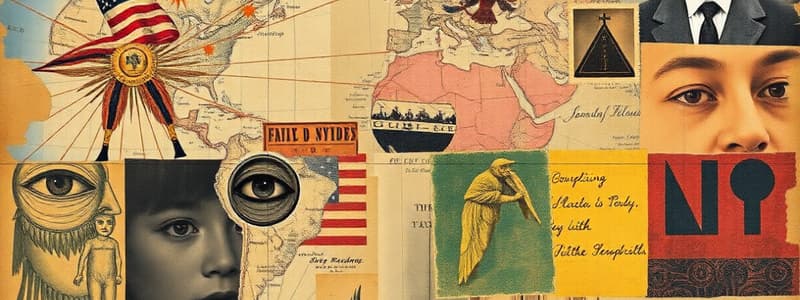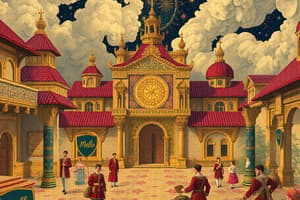Podcast
Questions and Answers
Which of the following best describes the Columbian Exchange?
Which of the following best describes the Columbian Exchange?
- The European exploration of the Pacific Ocean.
- The forced migration of enslaved Africans to the Americas.
- The exchange of goods exclusively between Europe and Asia.
- The exchange of people, plants, animals, diseases, and ideas between the Eastern and Western Hemispheres. (correct)
Mercantilism promotes free trade and open competition between nations.
Mercantilism promotes free trade and open competition between nations.
False (B)
What was the primary goal of mercantilism?
What was the primary goal of mercantilism?
To make a nation more powerful by accumulating wealth.
The economic system in which business is privately owned and operated for profit is known as ______.
The economic system in which business is privately owned and operated for profit is known as ______.
Match the following terms with their descriptions:
Match the following terms with their descriptions:
Which continent saw a population explosion due to the introduction of corn?
Which continent saw a population explosion due to the introduction of corn?
The introduction of horses to the Americas had no significant impact on Native American cultures.
The introduction of horses to the Americas had no significant impact on Native American cultures.
Name three animals that Columbus introduced to the Americas on his second voyage.
Name three animals that Columbus introduced to the Americas on his second voyage.
The grassy plains of South America on which horses and cows thrived are called the ______.
The grassy plains of South America on which horses and cows thrived are called the ______.
Match the following terms with their origin:
Match the following terms with their origin:
What was a consequence of European diseases on the people of the Americas?
What was a consequence of European diseases on the people of the Americas?
Civilizations in the Americas had access to the wheel and iron tools before the arrival of the Spanish.
Civilizations in the Americas had access to the wheel and iron tools before the arrival of the Spanish.
Name three technologies shared between hemispheres due to the Columbian Exchange.
Name three technologies shared between hemispheres due to the Columbian Exchange.
England established tea plantations throughout its empire in ______ and Africa.
England established tea plantations throughout its empire in ______ and Africa.
Match the following English actions with their effects to strengthen the Tea Trade:
Match the following English actions with their effects to strengthen the Tea Trade:
What was a key factor that led to the price revolution in Europe?
What was a key factor that led to the price revolution in Europe?
In a traditional economy, prices are determined by supply and demand.
In a traditional economy, prices are determined by supply and demand.
In the 1630s, which item saw a dramatic increase in price in the Netherlands before crashing?
In the 1630s, which item saw a dramatic increase in price in the Netherlands before crashing?
The system in which people wove cloth in their own homes is known as ______ industry.
The system in which people wove cloth in their own homes is known as ______ industry.
Match each occupation with the correct social class:
Match each occupation with the correct social class:
Flashcards
What is Mercantilism?
What is Mercantilism?
An economic system where nations strengthen themselves by expanding their trade, aiming to maximize wealth and power.
What is the Columbian Exchange?
What is the Columbian Exchange?
The exchange of people, plants, animals, diseases, and ideas between the Eastern and Western Hemispheres following Columbus's voyages.
What is Capitalism?
What is Capitalism?
An economic system where businesses are privately owned and operated for profit, driven by competition and free markets.
What is Cottage Industry?
What is Cottage Industry?
Signup and view all the flashcards
What is a Traditional Economy?
What is a Traditional Economy?
Signup and view all the flashcards
What is a Market Economy?
What is a Market Economy?
Signup and view all the flashcards
What is Inflation?
What is Inflation?
Signup and view all the flashcards
Impact of American crops?
Impact of American crops?
Signup and view all the flashcards
What was Spanish ranching?
What was Spanish ranching?
Signup and view all the flashcards
What caused the Price Revolution?
What caused the Price Revolution?
Signup and view all the flashcards
Study Notes
- The voyages of discovery initiated a global exchange of people, goods, and ideas.
- European nations embraced mercantilism.
- Economic changes in Europe fostered the development of capitalism.
The Columbian Exchange
- Columbus's voyages connected the Americas to the rest of the world.
- People, plants, animals, diseases, and ideas were exchanged between the Eastern and Western Hemispheres.
- The exchange of living things and ideas between the Eastern and Western Hemispheres is known as the Columbian Exchange.
- Enslaved Africans were among the early settlers crossing the oceans.
- There was a large migration in the 1800s, with over 50 million people from Europe settling in the Americas.
- People from Asia also migrated to the Americas starting in the 1800s.
- North and South America have diverse societies as a result.
New Crops, New Foods
- Plants from the Americas changed eating habits and helped increase global population.
- Maize, or corn, was a crucial plant, leading to population growth in Africa and Asia.
- Peanuts became a staple crop in Africa and were used for protein or cooking oil.
- Potatoes, manioc, beans, and tomatoes were important food crops.
- Plants from the Eastern Hemisphere also influenced the Americas.
- Sugar cane became a major profit source in the Caribbean and Brazil.
- Ranchers in the Americas used grains like barley and oats for livestock.
- New crops like rye, rice, grapes, bananas, and coffee transformed the Western Hemisphere.
Horses Arrive in the New World
- Conquistadors brought the first horses to the Americas
- A new way of life developed around the horse.
- Spanish ranchers used horses to herd cattle in the Americas in the 1500s.
- The horse became central to Native American cultures, who used them for hunting buffalo and warfare.
- South American gauchos and North American vaqueros were the first cowboys in the New World.
Other Exchanges
- European diseases had deadly effects on the people of the Americas.
- Sailors brought new diseases back to Europe from the New World.
- The Columbian Exchange led to the sharing of technologies.
- The Americas lacked the wheel, iron tools, firearms, and large work animals before the Spanish arrival.
- The Spanish admired the massive stone buildings made by the Aztec and Inca civilizations.
- Incan buildings could withstand earthquakes due to advanced carving methods.
Mercantilism
- Global trade changes led to mercantilism.
- Mercantilism is an economic policy that strengthens a nation by expanding trade.
- The goal of mercantilism is to accumulate wealth and make the nation powerful.
- Mercantilists believed trade's main goal should enrich the nation.
- Traders sold goods for gold and silver, which paid for a powerful army and navy.
- Mercantilists urged lawmakers to increase a nation's wealth by regulating trade and boosting production.
- Nations aimed to "sell more...yearly than we consume...in value."
- Most European nations adopted mercantilism by the 1600s and 1700s.
- Imports were taxed to exclude foreign goods and boost domestic markets.
Mercantilism in the Tea Trade
- Buying and selling tea and collecting tea tax revenues supported merchants, traders, and artists worldwide.
- England's tea trade exemplifies mercantilism.
- England established tea plantations throughout its empire in Asia and Africa.
- The British East India Company maintained high tea prices with its trade monopoly.
- The British designed swift ships to transport tea from China.
- English tea drinkers began sweetening tea with sugar.
- This increased sugar production in the Caribbean to meet the demand.
- British tea merchants opened shops to sell imported tea to the public.
- Tea drinking introduced new eating habits and teatime foods.
- English porcelain and silver manufacturers exported tea service items to the colonies and Europe.
- English artists received commissions to paint families drinking tea.
Sugar: A Sweet Story of Capitalism
- Europeans demanded more sugar by the 1600s, supplied by large plantations in the Americas.
- The sugar trade involved investment, land development, labor, and manufacturing.
- Profits from sugar were reinvested to continue the cycle.
A Commercial Revolution
- Expanded trade, money supply, and empire-building spurred capitalism's growth.
- Capitalism is a profit-driven economic system with private business ownership.
- It is also called the free market or free enterprise system.
- Prices for food and goods rose in the 1500s.
- There was also a sharp increase in money in circulation, leading to inflation.
- This historical inflation period in Europe is known as the price revolution.
- Rapid population growth increased demand for food, which farmers couldn't meet, raising food prices.
- Gold and silver from the Americas increased the money supply, driving up prices.
- Higher prices increased profits for landowners and merchants.
- They invested profits to increase businesses, with capital increasing profits.
- Land ownership is another aspect of capitalism.
- Individuals, not the government, owned the land and tools to grow crops.
- Individuals benefit from private ownership.
Tulipmania
- In the 1630's there was a frenzy over a single good: the tulip bulb"
- People made and lost fortunes
- The price of tulips rose dramatically and then abruptly crashed.
The Price Revolution and its Effects
- The price revolution benefited landowners most through higher crop prices and profits.
- Dutch and English landowners forced peasants off the land due to wool trade profits.
- Feudal systems ended in the Netherlands and England because peasant no longer farmed for lords.
- Many peasants moved to cities to find work.
- The price revolution drove up prices for goods like cloth.
- Cloth merchants wanted to produce more and make larger profits.
Goods and Profits
- English cloth merchants bought raw wool cheaply and had families spin and weave it.
- Merchants picked up the cloth and sold it for the highest prices, maximizing profits.
- People who wove cloth worked in their homes or "cottages."
- The cottage industry involved people using their own equipment and working long hours.
- Capital and labor became separated for the first time.
- Capitalists invested in coal mines, breweries, and shipyards in England.
- Dutch capitalists founded printing, diamond-cutting, sugar-refining, and even chocolate industries.
A Market Economy
- Changes in industry and agriculture changed English and Dutch economies.
- The Netherlands and England moved away from a traditional economy.
- In a traditional economy, goods are exchanged based on custom or tradition.
- A market economy bases prices and distribution on market competition, not fixed by guilds or customs.
- It requires private property, a free market, and profit incentives.
The Middle Class Grows
- Merchants and skilled workers in European cities became prosperous, forming a middle class.
- Hired laborers and servants lived in poverty.
- These changes needed time to reach all levels of society because much of the population remained rural.
Studying That Suits You
Use AI to generate personalized quizzes and flashcards to suit your learning preferences.




